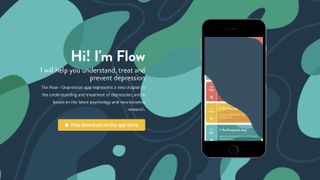You can now buy a brain stimulation headset to treat your depression
Could a brain stimulator really improve your mental health?

Could a headset and smartphone app really treat depression? That’s the claim made by Flow for its medically-approved brain stimulation headset, a device that nudges your neurons with a gentle electric current, and one you can buy and use in your own home.
Flow is a medical technology company founded in 2016, and is currently based in Sweden. Its CEO, clinical psychologist Daniel Mansson, founded the company after writing his master’s thesis on brain stimulation, and has years of experience working at the crossroads between psychology and software.
We've heard of electric shocks from headphones helping you to juggle, but can a hardware product really succeed in place of, or even begin to aid existing medical treatments for depression?
To get my head around the potential health benefits of a product like this, I spoke to Flow’s CEO Daniel Mansson, while handling a Flow headset to get a sense of the hardware on offer.
What is the Flow headset?

The Flow headset looks a bit like a miniature VR headset, except the curved white visor sits solely on your forehead, with a band hooking over the top of your head to hold it in place.
The box also comes with a box of single-use cloth pads to place between your skin and the suction pads on the headset, given that your skin likely wouldn’t respond well to direct electrical currents.
Treatments last around 30 minutes, “with 18 sessions over a 6 week period” (three times a week) or “as long as necessary”. The headset is designed to be used in tandem with a virtual therapy app, which helps to inform users about depression, and the kind of “lifestyle changes” the patient can make to do with their diet, exercise regime, sleep hygiene, and meditation (the app is only on iOS).
Get daily insight, inspiration and deals in your inbox
Get the hottest deals available in your inbox plus news, reviews, opinion, analysis and more from the TechRadar team.
"The headset delivers a gentle electrical signal"
There’s something slightly unnerving about the idea of self-administering a mild form of shock therapy, but there are existing forms of treatment that use the same underlying technology: transcranial direct-current stimulation (or TDCS).
This treatment is a non-invasive way of stimulating the brain with mild electric currents, using battery-powered electrodes.
Flow’s website states that “People diagnosed with depression often have a lower activity in the left frontal cortex of their brain. The headset delivers a gentle electrical signal which activates neurons and rebalances activity in the frontal lobe.
"The headset is based on a well-researched brain stimulation technology called Transcranial Direct Current Stimulation which, in clinical studies, has been shown to reliably improve symptoms of depression.”
Hang on, is this a real thing?

It the claims sound somewhat sci-fi, the technology has been undergoing numerous medical trials, with the evidence being enough to get the Flow headset approved for medical use in the UK and Europe.
Mansson tells me that Flow is seeking similar medical approval in the US, and is in talks with the UK’s National Health Service to offer the headset through prescription.
The treatment is listed on the NHS website as a method of possible treatment, and the National Institute for Health and Care Excellence (NICE) asserts there are “no major safety concerns”, though patients should be taken through the risks and side effects associated with it.
You are strongly advised not to use the headset without approval from a physician and an official diagnosis of Major Depressive Disorder. Anyone with a “pre-existing neurological” condition, or with broken skin at the point of contact with the headset, should be especially wary.
I erred on the side of caution here – as someone more familiar with anxiety treatments than those used for depression – so can’t speak about the effectiveness myself.
However, both the British Journal of Psychiatry and New England Journal of Medicine have published the results of randomly-controlled trials using the kind of brain stimulation utilized in the Flow headset.

Both trials cited above worked with several hundred patients (289 in the former, 245 in the latter), with the British Journal of Psychiatry calling the treatment “comparable” to “antidepressant drug treatment in primary care”.
The New England Journal of Medicine, however, was more hesitant, reporting “more adverse” effects – such as “skin redness, tinnitus, and nervousness [...] and new-onset mania” – without obvious improvements compared to other forms on therapy. Another study published by online journal Brain Stimulation advised against its use for patients prone to seizures or epilepsy.
Flow’s CEO Daniel Mansson says the company worked for over two years on “making sure that all of the safety standards and good manufacturing practices were met and documented” before getting the stamp of approval in June 2019.
But some scepticism is appropriate, given the inconsistent results of the mental health treatments previously available to patients in the UK and Europe.
Depression, for all its prevalence in our society (the World Heath Organization estimates 300 million people living with the condition worldwide), is really not understood very well – and there are a host of different strategies for tackling the affliction.
You might be recommended in-depth psychoanalysis to understand underlying psychological causes, given cognitive behavioural therapy to tackle behavioural symptoms, or given medication as a chemical solution – if not a combination of the three, with varying degrees of success.
You might also not be recommended these things when you need them, given how hard mental illness can be to diagnose. So offering a DIY solution you can buy yourself – circumventing lengthy and potentially triggering consultations, even if you’re not meant to do so without medical approval – does offer a convenience in its own right.
"The combination of the brain stimulation headset and therapy app,” says Mansson, “creates a new, very powerful, but also very safe, at-home treatment solution.”
Treating yourself

There’s been huge growth in kind of self-care and meditation apps like HeadSpace – often actively recommended by GPs in the UK – offering ways to manage stress, pain, or anxiety.
"We are seeing a shift from pharmacological treatments to more digital therapy-based alternatives"
Naturally, cost becomes an issue when patients are expected to find healthcare solutions outside of national health services. The Flow headset costs £399 (around $480 / AU$710), without any supplementary costs – while the HeadSpace app, by comparison, will set you back $95 / £72 / AU$149 for a year’s subscription.
Mansson makes sure to say Flow is only one tool “in the toolbox of treatments”, but as a commercially-available hardware product, it has the potential to change the way patients commonly receive treatment, especially if the costs are scaled down.
“Right now we are seeing a shift from pharmacological treatments to more digital therapy-based alternatives,” says Mansson, “which empower patients and motivate them to treat their own condition from the comfort of their home.
“Given that brain stimulation devices (if medically approved) offer few side effects and are affordable and accessible, it makes perfect sense that devices such as Flow will become increasingly popular.”
So... should I get one?
Well, not off your own bat. The jury's out on the efficacy of tDCS, even if it's slowly gaining more traction as a potential aid for major depressive disorder.
Given the growing push towards more digitally-based therapies and care treatments, though, the signs suggest that there’ll be more treatments like these being suggested by medical practitioners going forward.
But neither Flow or I would recommend picking this up on a whim, and you really should wait until your doctor recommends it, to help with your specific needs.
For more information you can head to the Flow website.
Henry is a freelance technology journalist, and former News & Features Editor for TechRadar, where he specialized in home entertainment gadgets such as TVs, projectors, soundbars, and smart speakers. Other bylines include Edge, T3, iMore, GamesRadar, NBC News, Healthline, and The Times.

